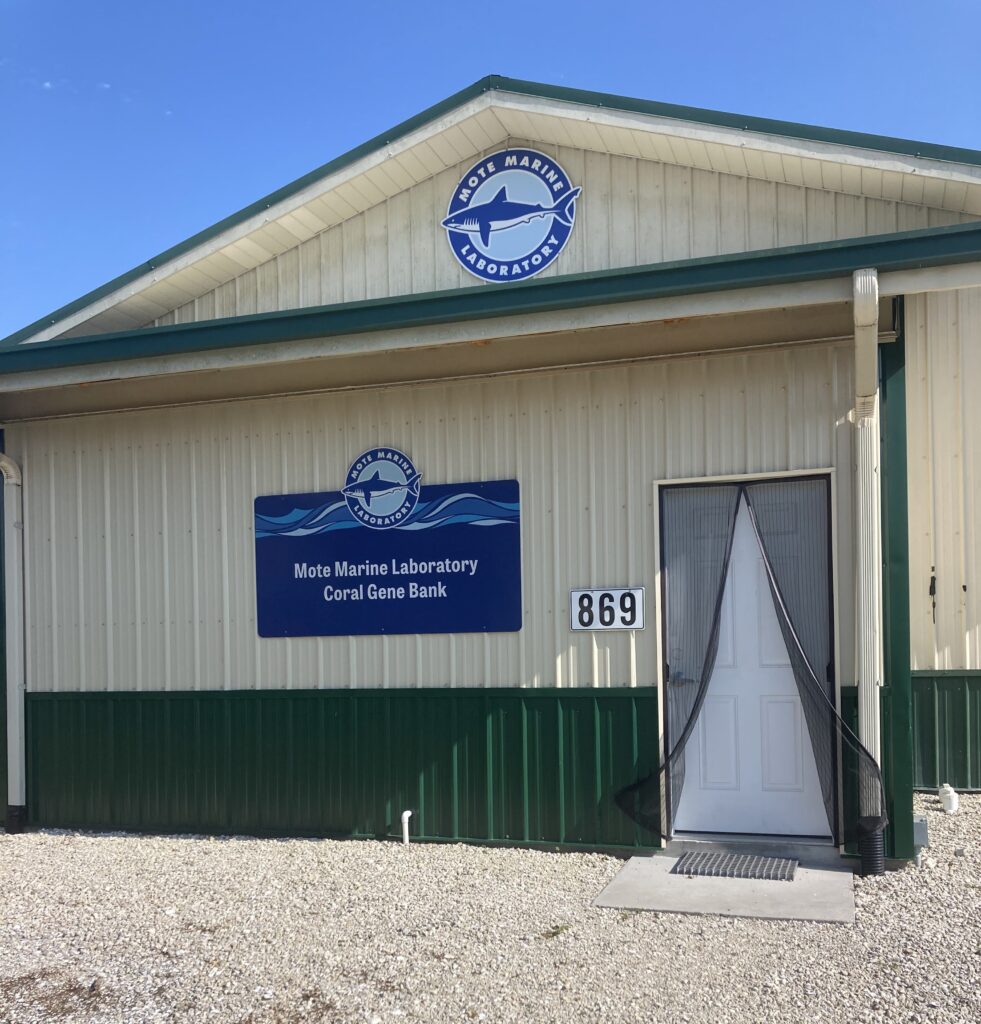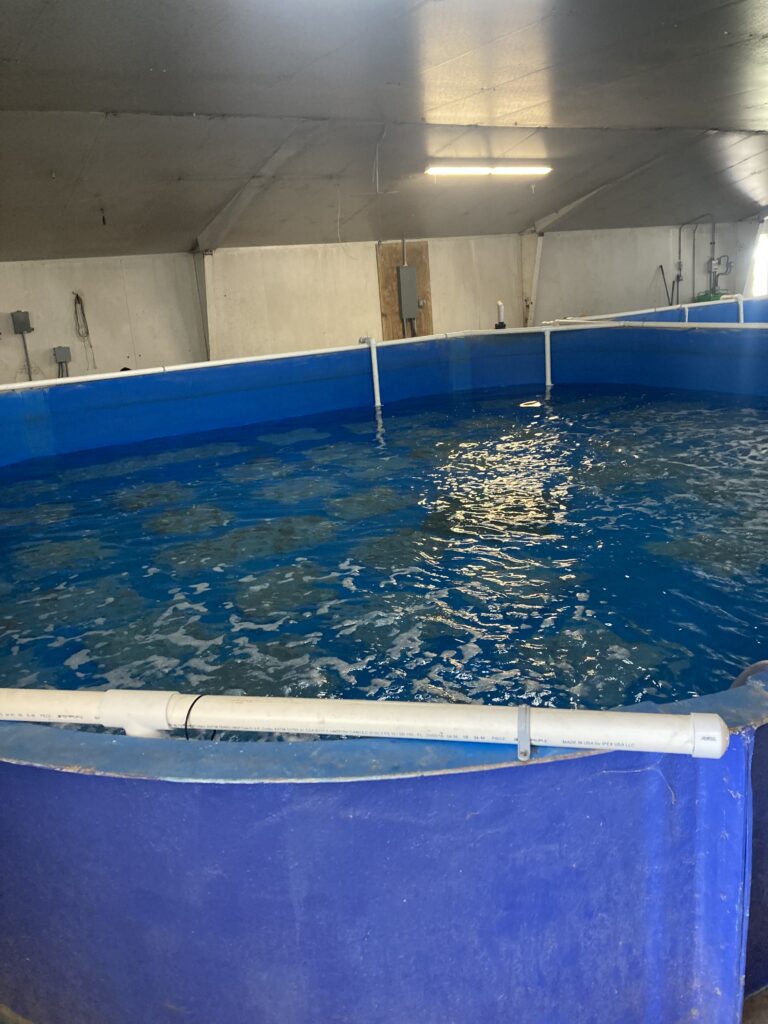Coral reefs are a vital ecosystem. Not only do they support a diverse array of wild life but they also play a crucial role in coastal protection and fisheries. The individual corals that make up the coral reefs are composed of tiny polyps that secrete a calcium carbonate skeleton, giving corals their rock-like appearance. As the polyps grow and multiple the coral will grow in size. Unfortunately, coral reefs are delicate ecosystems and face many
threats including ocean warming, ocean acidification, overfishing, and habitat destruction. It is imperative that steps are taken to protect this essential ecosystem.
This summer, I had the amazing opportunity to intern at Mote Marine Laboratory and Aquarium’s Coral Gene Bank. The Gene Bank, which acts just like a seed bank, houses over 25 different species of Caribbean corals. The Gene Bank is located at Mote’s Marine Aquaculture Park which is located almost 15 miles from the ocean. This means that all salt water at the Gene Bank is made there and recycled. A lot of my job consisted of making sure the salt water in the tank was suitable for the corals. This included keeping the temperature and salinity (how salty
(how salty the water is) consistent, dosing the tank for missing elements, and changing and cleaning filters to keep the water clean. My absolute favorite task was feeding the corals. At the end of every day, I would get to hand feed every coral with a pipet. Whoever said that corals are just

colorful rocks have never seen a coral feed. The polyps get super excited and all their tentacles come out as the grasp for food
One of the most exciting parts of my internship was assisting with coral spawning. Corals use a variety of cues to synchronize their spawning. These cues include temperature, lunar cycle, light, and more. The spawning tanks were set up to replicate actual ocean conditions except the lights in the

tank were set to be night time during our day. This was done because coral spawn at night and the biologists want the corals to spawn during the day so we could monitor them. The corals that we were monitoring were set to spawn after either of the two full moons that occurred in August this year. My job involved supervising the corals every 15-20 minutes to check for spawning throughout the day. During my time at the Gene Bank, two corals of the same species spawned! I got to help collect the gametes, fertilize the eggs, and settle the larvae. This was such a unique experience! These corals will be grown in the Gene Bank until they are large enough to outplant on the reef.
In mid-July, the sea water in the Florida Keys were hit with record high temperatures of over 100 degrees! Because of the extreme ocean temperature, MOTE’s ocean-based coral nurseries, as well as other nurseries in the Keys, were reporting a mass bleaching event. Bleaching occurs when a coral becomes heat stressed and kick out the symbiotic zooxanthellae that live in their tissues. Zooxanthellae are photosynthetic microbes that are essential to coral health because they provide food for the corals. Corals can survive short amounts of time without their zooxanthellae before they die, however, temperatures on some reefs were so high that the corals were dying before they could even bleach.
The Coral Restoration Foundation. in fact reported almost 100% coral mortality on several reefs in the Lower Keys.
What followed this news was a mass coral evacuation from the Florida Keys. The Gene Bank staff and I, as well as scientists from the main aquarium, were recruited to assist with the setup of tanks and the delivery and care of the evacuated corals. Over the course of a week,

the Aquaculture Park received several thousand rescued Staghorn corals. This was an incredibly daunting task as there was no infrastructure to care for the sudden influx of corals. The day before the first corals arrived, thousands of gallons of saltwater were delivered in order to fill the massive tanks that were meant for the aquaculture of crabs. The corals arrived early the next morning. When they arrived, they were rushed into the tanks where over the course of the next few hours they were organized by genotype and tagged.
The first batch of corals that arrived looked healthy, however the rest of the shipments of corals were in far worse shape. The next day, double the amount of corals arrived. Unfortunately, many arrived bleached, dying, or dead and by the end of the day we had lost at least half the corals that had
arrived that morning. The corals that arrived the rest of the week didn’t look much better. Clearly the water temperature and the stress of transport were worsening the coral’s health. Despite the many losses, the corals that did survive wouldn’t have if they hadn’t been evacuated. This mass effort would not have been possible without the amazing people that stepped up to help. From those in the Keys who were scuba diving and removing corals from the reef, to the volunteers who drove through the night to reach the Aquaculture Park, and to the scientists who continue to care for the corals now.
These rescue corals will stay at the Aquaculture Park until water temperatures drop. This mass bleaching event serves as a stark reminder of the vulnerability of coral reefs. As we look ahead, we must consider the fate of our coral reefs and the growing importance of coral gene banks. Coral gene banks are built to help our corals recover from catastrophic events like this bleaching event. The Gene Bank ensured that the death of those corals did not mean the disappearance of that species genetic diversity. This gives me hope that one day our coral reefs can recover.



